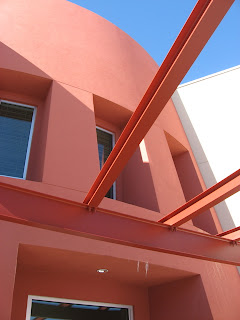 "Gently resisting change since 1872."
"Gently resisting change since 1872."That's the tagline for the village of Gruene, Texas. Located midway between Austin and San Antonio, it features a whole community of 19th century residences and businesses, which owe their survival to the Depression.
But before that, Henry Gruene built a home for himself and one for his foreman, a cotton gin, a "mercantile", and a dance hall/saloon. Business thrived in the late 19th and early 20th centuries, but after a major boll weevil attack and the sorrows of the Depression, the town was largely abandoned. As a result, 1970s restoration efforts had a treasure trove of original architecture to work with, and today the town evokes its origins in several streets of quaint shops, antique stores, and the original dance hall--Gruene Hall. (Unlike the rest of town, the dance hall/saloon never closed!)
 On a recent trip to San Antonio, we detoured to Gruene to listen to Santa Fe musician Bill Hearne in the dance hall, meet an Austin friend for lunch, and tour the town. One of the things I really enjoyed was the wordplay in the naming of the shops, restaurants, etc. Though the original German name would have been pronounced "Groon'eh", the locals pronounce it "Green"--and that's how you have to read the signs in this post.
On a recent trip to San Antonio, we detoured to Gruene to listen to Santa Fe musician Bill Hearne in the dance hall, meet an Austin friend for lunch, and tour the town. One of the things I really enjoyed was the wordplay in the naming of the shops, restaurants, etc. Though the original German name would have been pronounced "Groon'eh", the locals pronounce it "Green"--and that's how you have to read the signs in this post.



.jpg)






